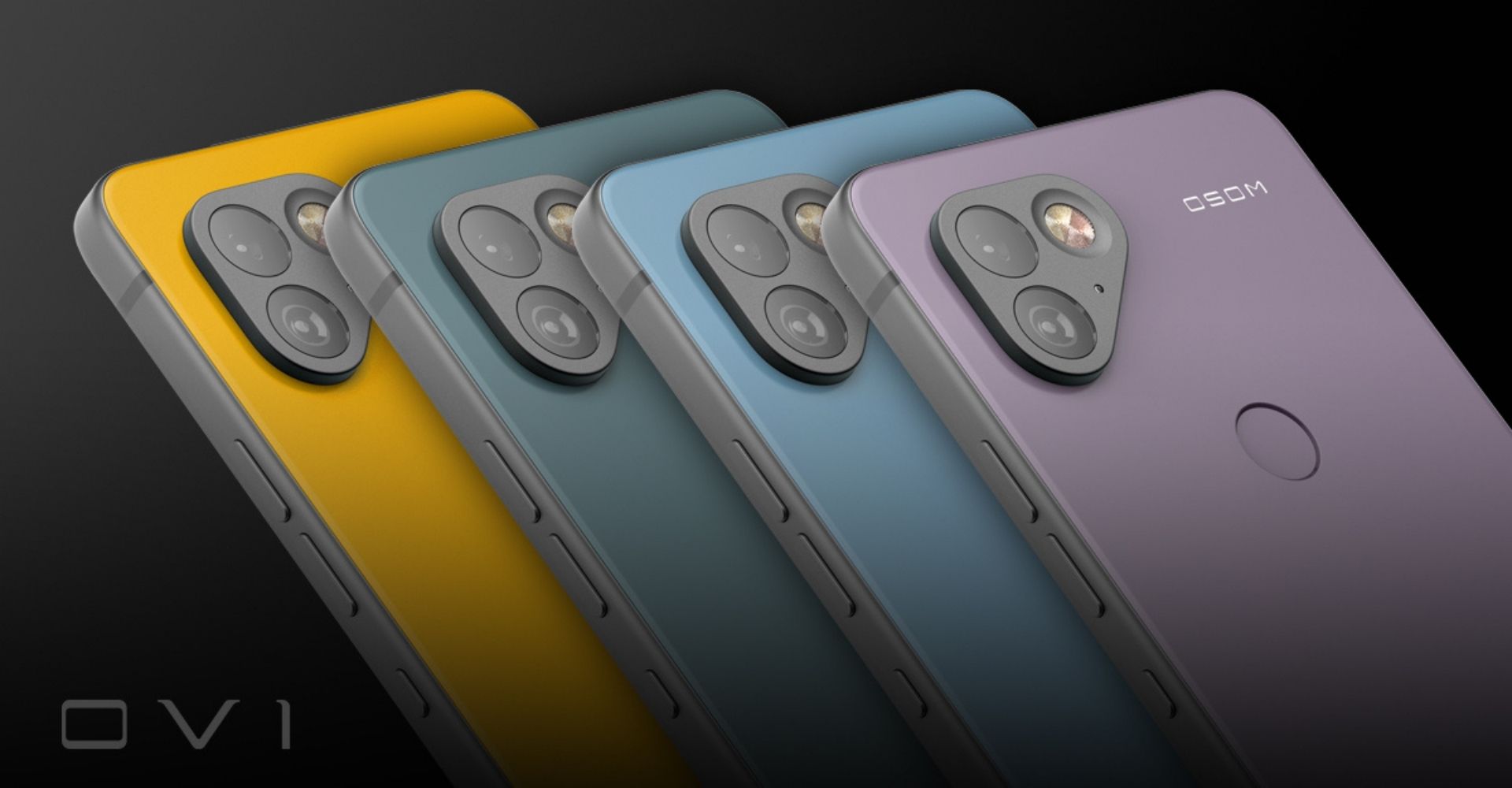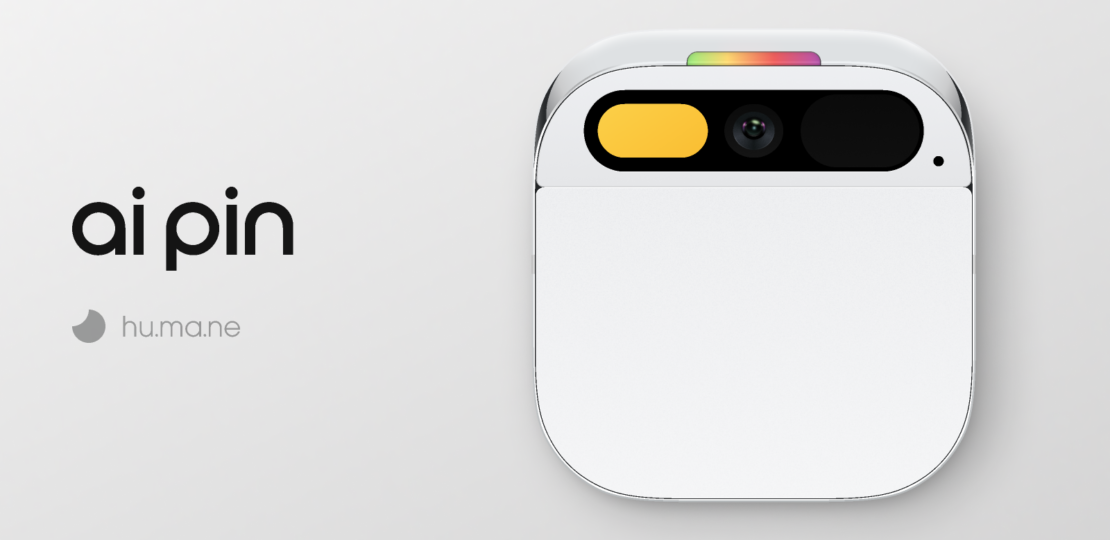
This is the Humane AI Pin, a brand-new product that’s pretty fascinating as a super futuristic wearable computer. In a world full of new gadgets like the Vision Pro and smart glasses, it’s exciting to see genuinely fresh, first-generation products like this one. That said, as cool as it sounds, I have to say it’s also probably the worst product I’ve ever reviewed in its current state. There are so many issues with it, and honestly, it’s tough to even figure out what the point of the device is when you get into it. So, for this video, I’ll break it down in two parts: first, I’ll explain what it’s supposed to do, and then I’ll talk about my experience actually using it.
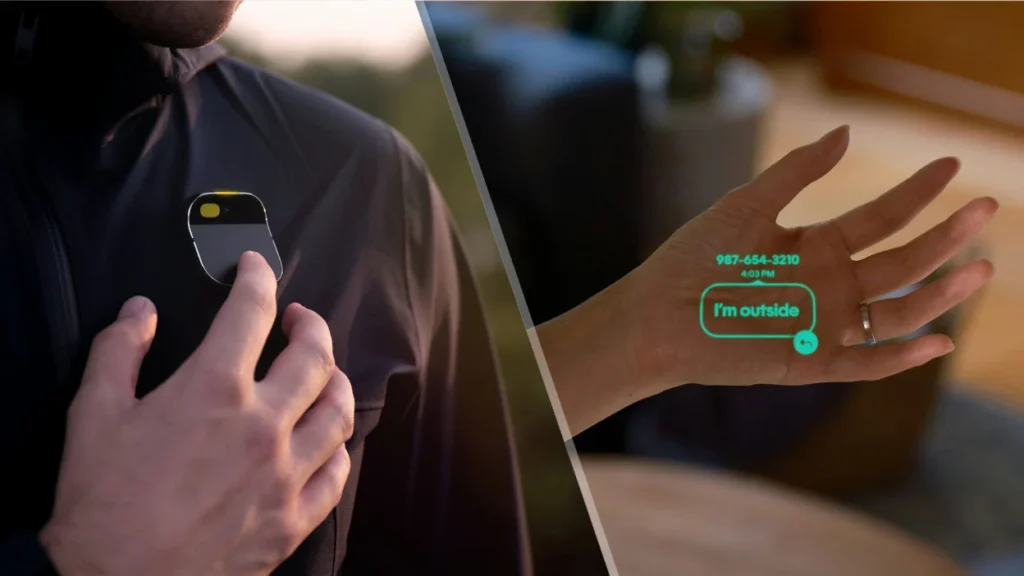
The Humane AI Pin is a small wearable computer with an AI inside to help you through your day. It’s about the size of a large watch and has a camera, microphone, and touchpad. It can even interact with the world around you, and there’s also a projector built in with a new gesture control system that projects onto your hand. The price tag? $700, plus a $24-a-month subscription for the data, services, and cloud storage. So yeah, $700 plus a subscription—it’s already off to a fun start.
Now, one of the major things to know is that this device doesn’t pair with your smartphone at all. It’s a standalone gadget with its own internet connection and its own phone number. The idea is that this AI assistant is with you everywhere, constantly connected, and you can decide how much you want to use it alongside your phone. It sounds nice in theory—like, you talk to it like it’s a person, and it can answer questions, give you historical facts, make recommendations, help with brainstorming, and even send texts or make calls.
The problem, though, is that it’s just too clunky to use for most of those tasks when you’re already carrying your phone around. And I’ll explain why in a bit.
The Hardware
Let’s talk about the hardware. Honestly, the build quality is pretty impressive. If you’re looking for a reason to feel like you’re not getting ripped off, the packaging and the way everything’s put together really does that. The pin itself feels solid—it’s made of aluminum and has a nice weight to it. There are three colors to choose from: the basic matte black, which is the cheapest option, or for an extra $100, you can go for the white version or this black and silver one I’m using.
Inside the pin, there’s a ton of tech packed into a small space—cameras, microphones, lights, and even a tiny Class 2 laser projector. It’s all crammed in there, and the magnets that hold everything together are really strong. The back of the pin has something called a “booster,” which is another battery. The pin has its own battery, but when you attach the booster to your clothes, it magnetically connects and charges the pin. It clicks into place with a satisfying sound, which is a nice touch.
You get two boosters with the pin, so you can swap them out and keep it running without missing a beat. Very smart. Plus, it comes with a sleek, reflective charging case that you can use to charge the pin or just the battery via USB Type-C. There’s also a desktop charging puck, where you can magnetically attach the pin and booster, or just the battery, to charge everything at once.
That’s a lot of charging accessories, but they’re all included. The pin also has these lights on top that light up when you’re using it, and a small indicator light to let you know when there’s something waiting for you. Between the weight of the materials and how strong the magnets are, you can tell a lot of thought and effort went into making this thing. It’s definitely the best part of the pin, by far.
What Does It Do?
Imagine for a second that your smartphone isn’t in your pocket. Just forget about it for a moment. Now, focus on this small pin—it can do a lot and be super helpful. Think of it like an AI assistant that’s always with you.
To interact with it, you simply touch the pin. There’s no need for a wake word—it activates and listens only when you tap it. For example, you can ask it something like:
(AI Pin beeps)
How tall is the Empire State Building?
(AI Pin beeps)
After you let go, it sends your question to the cloud.
(AI Pin responds)
The Empire State Building is 1,454 feet tall to the tip.
It doesn’t just answer questions. The pin is also multimodal, meaning it can see and interact with the world around you using its camera. For example:
(AI Pin beeps)
Look and tell me what you see.
(AI Pin beeps)
The pin scans your surroundings, sends the image to the cloud, analyzes it, and gives you a response.
(AI Pin responds)
You’re sitting in front of a camera and a laptop. The camera is on a tripod, pointed at you. The laptop is open, and you’re looking at it. There are three pictures of dogs on the wall behind you. A window is to the left of the camera. There’s a boom mic on the table, and a red carpet on the floor.
The camera can also take pictures or record short videos (up to 15 seconds), automatically uploading them while it charges. The pin also has memory—it can remember things you ask it to, and all that info is saved in the Humane Center, a web portal where you can access everything related to the pin. There’s no app—just a website where you can see a history of your calls, texts, what you’ve listened to, what it’s answered, and anything you’ve asked it to remember.
One of the coolest features is the translation function. With just a simple two-finger gesture, you can:
(AI Pin beeps)
(You speak in Spanish)
(AI Pin beeps)
(AI Pin responds)
Where’s the library?
The pin automatically detects the language, translates it into English, and when the person replies, it will translate that back for you. All you have to do is hold the pin and let it listen. It’s a pretty awesome feature!
This device is all about voice commands, so if you’re in a noisy place or somewhere private where speaking out loud isn’t ideal, that’s where the projector comes in. It might sound strange, but you activate it like this, hold your hand out, and it turns your palm into a projection screen for the built-in laser projector. It takes a bit of practice to position your hand just right, but once you get the hang of it, the UI is projected onto your hand in a green 720p display. To interact with it, you keep your hand as flat as possible and use hand gestures. The time-of-flight sensor tracks your movements, so you can “roll” your hand like you’re moving a marble to make selections. A pinch confirms your choice, a fist takes you back, and pushing forward moves you through the menu. It’s a 3D UI that’s new for most people, but honestly, it’s pretty intuitive. A quick 60-second demo and you’ll have it down.
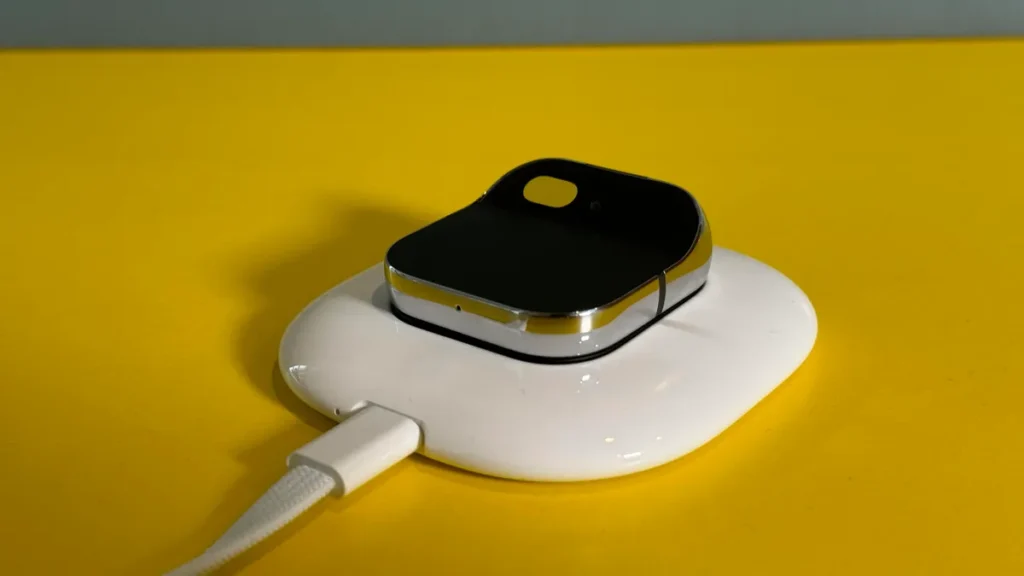
When you first connect the booster to the pin, you can unlock it by moving your hand through space to select the numbers. It’s like flipping through a Rolodex of numbers. The first time you use it, it feels a bit magical—once you see it, it just clicks. Even though it’s a little fidgety and slow, it works. But now let’s talk about the review.
The Review (It’s Not Great)
Unfortunately, this thing doesn’t do much well. Where do I even start? It’s supposed to answer questions, right? Sometimes it can do that, but it’s often slow. A lot of requests go to the Cloud, and there’s a noticeable delay as they come back. Plus, it gets things wrong a lot. AI still makes mistakes—it misunderstands questions, gives wrong answers, or just doesn’t get it right. And don’t even get me started on server timeouts, especially if your internet connection is weak, which happens a lot for me in this studio. In their demo videos on the website, they often ask a question, then keep talking to fill the silence while they wait for the answer, so it doesn’t feel awkward. But even with fast Wi-Fi here…
(AI Pin beeps)
“Who designed the Washington Monument?”
(AI Pin beeps)
[AI]: “Finding designer…”
“The Washington Monument was designed by Robert Mills, a prominent 19th-century American architect from South Carolina. The construction was eventually completed by…”
You can just hold your hand up to get an answer from the AI Pin and interrupt it when it’s talking too much. Even with that, it still does a pretty good job when the Wi-Fi is fast and conditions are ideal. But honestly, there are so many times when it feels really slow. It seems like it’s constantly sending requests to the internet for everything. There are a few things it handles quickly, like:
(AI Pin beeps)
What time is it?
(AI Pin beeps)
[AI Pin] 11:42 AM.
That’s pretty fast. If I ask about battery life, it gives me that info pretty quickly too. But most of the time, it feels like it’s just sending everything to the cloud instead of processing it locally, and it takes forever. Plus, it often gets things wrong. I remember asking it a few days before the solar eclipse when the next one would be, and it told me 2044. I asked, “What’s some good Asian food around here?” and it kept hearing, “What’s the best ash?” for some reason. I also asked about the next Nets game:
(AI Pin beeps)
When’s the next Nets game?
(AI Pin beeps)
[AI Pin] The next Brooklyn Nets game is on Sunday, April 14th, but I don’t have any details on the opponent or location.
I just Googled it, and it turns out it’s the 76ers. So, that’s a little off.
(AI Pin beeps)
What’s the traffic to the Empire State Building from here?
(AI Pin beeps)
[AI Pin] Looking up directions.
Use the voice command feature of the AI Pin to get traffic details to the Empire State Building, and it’ll give you all the info you need.
I already did that? This kind of thing happens all the time.
And then there’s the battery life… It’s bad. And it’s super inconsistent, which is so frustrating. It’s already annoying to have yet another device you need to charge every day, but with this thing, it’s worse. You’re constantly having to keep an eye on the battery, swap out boosters, and charge it multiple times a day.
As I mentioned earlier, you get two of these with the product, and I’ve had mixed experiences with the battery life. Sometimes the pin drains the entire booster battery in just two hours, even when I’m not doing much. Other times, it lasts about four hours, even while I’m taking photos, recording videos, handling requests, and using the laser. It’s also constantly warm, pretty much all the time, which feels a bit concerning.
There have been times when it just overheats for no apparent reason, and it asks me to wait for it to cool down. I think the heat issue is partly because of the fabric gap between the booster and the device, which is inductively charging it. Wireless charging is impressive but notoriously inefficient, and a lot of that energy is lost as heat, so it’s no surprise it stays warm.
That constant warmth, combined with the weight, meant I was always aware that I was wearing it. The hardware is really impressive, but it’s just a bit heavy. You can see the little sag, and it reminds me of how the Vision Pro feels too heavy when you wear it. With wearables, the goal is to make them as light as possible, which is why so many devices are made of plastic. But opting for aluminum here just makes it a little too heavy.
In the videos from Humane, people are often wearing thick fabrics and heavy jackets, so the sagging isn’t as noticeable. But if you wear lighter clothes, especially in warmer weather, you really start to feel the weight. Sure, there are lighter accessories available, but you can’t completely forget it’s there.
One downside is that the pin can’t set a timer or an alarm, which is a bit of a letdown. The notification light is positioned in the corner, which works, but it’s so far out of my peripheral vision that I hardly ever notice it. And since the light is placed on the corner, it seems like it’s meant to be worn on the left side of your body, which is fine, but that’s also right where most seatbelts sit (at least in the U.S.). It’s not a huge issue, but just another small inconvenience.
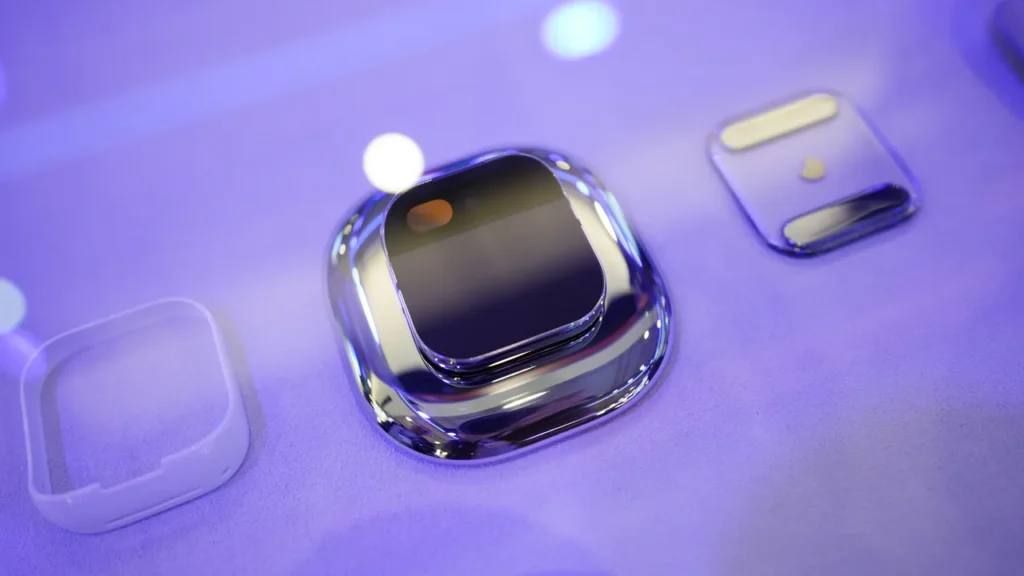
The photos aren’t great, and the videos are even worse. They’re square-ish, grainy, and capped at just 15 seconds. The hub that syncs everything often just stops working randomly, and I have to refresh it to get it going again. As for the projector, it’s impressive technically, but not easy to read. It’s not bright enough for outdoor use, and it dims the farther away it is from your hand. Unless I already know what the text is, it’s almost impossible to make out.
And the lack of apps is a big problem. When you first set up your Humane account, you can sync it with just four services: Apple, Google, Microsoft, and Tidal. The first three sync your contacts, while Tidal is the exclusive music partner. That’s it—no Uber, no Spotify, no WhatsApp, no Gmail, no calendar. It doesn’t do the basic things my phone can do, like booking a flight or shopping on Amazon.
Smartphones are just too powerful.
I’ve pointed out some of the issues with this device, but honestly, the biggest problem is that smartphones are simply way more advanced. After spending a week with the pin, I’ve realized smartphones are here to stay. A lot of online comments have already mentioned this, even before trying the device. There’s a lot of overlap between what this pin does and what a smartphone already offers—but everything the pin does, a smartphone does better, faster, and with higher quality.
Your phone takes way better photos and videos, is easier to use for calls and texts, and works in any situation—whether you’re in a noisy place or somewhere more private. Plus, you can search the web, message people, and access all kinds of apps that handle pretty much everything you need.
Have you ever tried sending a picture with the AI Pin? It’s easy enough on your phone, but with the AI Pin, it’s a little different. You take the photo, then either use your voice or pull it up manually, but when it shows up, it’s just a 720p green JPEG on your hand. It’s a decent preview, I guess, but then you go to send it. You either choose a contact or type in the phone number with gestures, and eventually, you hit send. The AI Pin uses its own internet connection to send a link to view the image in the Humane web portal. The process is just way less smooth than what you can do on your phone—it’s not even close.
Honestly, there are times when I’m using the AI Pin, and I’m asking it something, waiting for an answer, and I have my phone sitting right there, ready to give me the answer in seconds. It really makes you realize how much phones can do in comparison.
For example, if I ask the AI Pin something like, “What is this?” and it beeps, tells me it’s a Cybertruck, I’ll know the answer. But if I want to do a quick search or check something, it’s just faster on my phone.
When I say phones are “overpowered,” I’m talking about the convenience of having a screen right in your hand. With the AI Pin, you can do a lot with just your voice, but there are always those little moments when it falls short. For example, if I’m ordering an Uber, I could say, “Take me to the studio,” but if I change my mind and want to pick up something at Starbucks on the way, how would I change my pick-up location? With my phone, I could do it in a couple of seconds. With the AI Pin? Not so much.
And shopping is another area where phones still win. I’ve seen demos where people ask the AI to plan a trip or an expedition, but I’m not ready to trust it to buy something as simple as detergent. I need to read reviews, check ratings, and make sure I’m getting the right product. I’m not going to leave all that to voice commands alone.
I think, most importantly, I really love the idea of a virtual assistant that you can actually talk to like a human. It’s something we’ve been trying to do for years with Google Assistant, Siri, and Alexa. And now, with this new kind of AI device that can be with you everywhere, it feels like we might finally get closer to that. But here’s the thing: a good assistant has to know everything about you, just like a human assistant would. It needs to understand your schedule, where you go, who you talk to, and even your preferences, both personal and for products. It needs to be in the loop on everything.
Now, your smartphone already knows a lot about you. But this device doesn’t connect to your phone, so it doesn’t have access to all that information. Right off the bat, that puts it at a big disadvantage compared to your phone when it comes to being helpful. Sure, you can try to dive in and use it fully, telling it to remember things, or even make calls and send texts from it. But it will always have that gap. Plus, it has its own phone number, so if you call or text people from it, the device won’t be able to see the full context of your ongoing conversations. It can summarize messages, but that’s not the same thing as knowing the entire thread. That gap will always be there.
So, why didn’t they just make it connect to your phone? I think that’s what a lot of people are wondering. My guess is that Humane wants this device to be a powerful, standalone product in the future. To get there, though, they can’t start by linking it to your phone because that would make it harder to move away from that connection later. They don’t want to have to backtrack.
In a way, this device feels like it’s being held back by its vision for the future. It’s kind of like what I mentioned in my review of the Vision Pro. That device doesn’t pair with your iPhone either—it’s meant to be a standalone thing. Apple’s thinking long-term, imagining a future where something like that could work on its own, without needing an iPhone at all. But for now, both this device and the Vision Pro are limited by that bigger picture vision for what they’ll be down the road.
It was really tough to come up with a title for this video. I ended up calling it A Victim of Its Future Ambition, but at one point, I considered calling it, “This product is either the dumbest thing ever, or I’m just an idiot.” Because right now, it’s honestly pretty terrible. But every once in a while, and I mean every once in a while, it works perfectly—quickly, just as it’s supposed to—and in those moments, I think, “Okay, this is how it’s supposed to feel.” Then, I try it again, and reality smacks me right in the face.
Let me give you an example. I’ve said this a million times, but my best ideas always come at the worst times—like right before I fall asleep, in the shower, or while I’m driving. So the other day, I’m driving to the studio, and I have an idea. I’m not going to try to write it down on my phone while driving, obviously. But I’ve got the pin with me, so I just…
(AI Pin beeps) “Remind me of this cool ABC outro idea for the Humane review.”
(AI Pin beeps) And I just kept driving. It saved it.
[AI Pin] Saving memory.
[AI Pin] The outro idea for the Humane review has been saved.
Okay, the voice is a little annoying, but now that idea is in the Humane AI Center, waiting for me when I get to the studio. That was actually pretty useful. Another example? The first-person videos. I can wear the pin on my chest and record videos without worrying about distracting myself while driving. Even though the quality isn’t amazing, it’s a really frictionless way to do it, especially when you compare it to using smart glasses. That’s pretty cool.
But if you’re wondering, “Who should buy this device right now?”—the honest answer is no one. But if there’s one type of person who might actually find it useful, it’s someone who wants to spend as little time as possible staring at a screen. I’m that person sometimes—I don’t want to get sucked into endless scrolling the second I pull my phone out of my pocket. For that person, this device offers a small glimpse of hope for a future with less screen time.
The problem, though, is that there’s so much friction, confusion, and annoyance that it makes you not want to bother. Even though it could help you live more in the moment, the hassle just gets in the way.
I had a moment like this recently. We were filming in Ohio, which meant a travel day. I woke up that morning and thought, “I really don’t want to deal with this pin today.” I knew I’d be driving, so the seatbelt would be a pain. Then we’d go to the airport, I’d have to take it off for security, log in again, and deal with all the little annoyances. I just thought, “I’m not charging this thing seven times today. I’m not wearing it.” So I skipped it. Honestly, you should probably skip it too.
And here’s the thing: never buy a product based on the promise of future updates. This device clearly has a long way to go. There’s a team behind it, and I respect that—they’re trying to create something new, and we don’t see a lot of totally new products these days. But it’s clear this product needs a lot of work. They’ve shared a roadmap with some promising features, like number sharing, but there’s no timeline or details about when any of that might actually arrive
RELATED POSTS
View all
